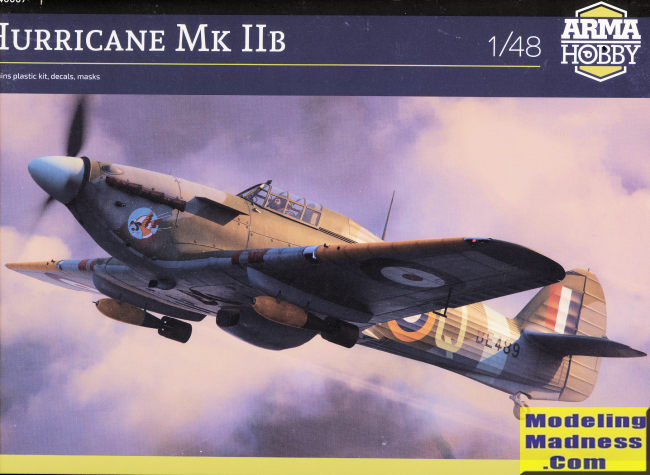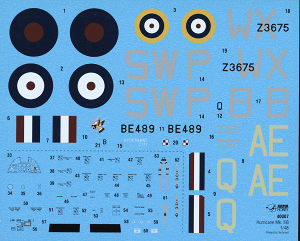
| KIT #: | 40007 |
| PRICE: | $68.00 SRP |
| DECALS: | Three options |
| REVIEWER: | Scott Van Aken |
| NOTES: | 2023 release. Includes canopy masks |

| HISTORY |
The Mk.IIB: The improved Merlin XX (Mk.20) engine appeared in 1940 featuring a new two-speed supercharger that could have its impeller speed changed by the pilot depending on the outside air pressure (altitude). At about 18,000 feet (5,500 m) (effective), it would be switched to a higher speed gearing ("FS ratio" – Full Supercharge) for added compression, while below that, at its lower speed gearing, ("MS ratio" – Moderate Supercharge), it "robbed" less power from the engine. The result was more power at both lower and higher altitudes, dramatically increasing the overall performance of the engine, peaking at 1,280 horsepower (950 kW). Because of the new engine, the bay immediately in front of the cockpit was lengthened by 4 inches (100 mm). The carburettor air intake under the forward centre-section was redesigned and moved back 3 inches (76 mm). The more powerful engine was cooled by a 70% to 30% water glycol mix, rather than pure glycol used for earlier Merlin versions. This and the increased cooling requirements required a larger radiator and a redesigned, circular oil cooler housed in a deeper, slightly wider "bath".
Trials with 12 .303 in (7.7 mm) Brownings (four per wing in the original gun-bays and two more in new gun-bays outboard of the landing lights) were done in June and July 1940, production began at Hawker and Austin in February 1941. These aircraft also featured a new longer propeller spinner. The tailwheel recess on the ventral keel was changed in shape and the tailwheel leg became a levered-suspension unit with a small torque link.
| THE KIT |
 Prior to the release of this kit, the one chosen by most
people was by Hasegawa. However, this kit tended to be expensive and could be
difficult to locate, though it could be found at swap meets and similar venues
for a reasonable price. Now I do realize that both Airfix and Hobby Boss do 1/48
Hurricanes and they are newer toolings than the Hasegawa, but like 109s and
Spitfires, there are a lot of variants and this kit, along with a Hasegawa tooling
are pretty much it for the IIb version.
Prior to the release of this kit, the one chosen by most
people was by Hasegawa. However, this kit tended to be expensive and could be
difficult to locate, though it could be found at swap meets and similar venues
for a reasonable price. Now I do realize that both Airfix and Hobby Boss do 1/48
Hurricanes and they are newer toolings than the Hasegawa, but like 109s and
Spitfires, there are a lot of variants and this kit, along with a Hasegawa tooling
are pretty much it for the IIb version.
Before starting, one has to decide if one wants bombs or fuel tanks under the wings as holes need to be drilled to accept them. The wing gun openings also need to be drilled as they are just dimples. Actual gluing starts with the main gear wells. With that done the seat is built up. Decals are provided for the harness. One then needs to remove the drop tank mounts molded onto the lower wing. Then the main gear well is attached to the lower wing along with the landing lights before the upper wing sections are attached.
Then the rest of the interior is built up on the lower wing. This includes side framework and the bits that are usually attached to them. It is interesting that the instructions would have you cut the main instrument panel decal into five pieces in order to have it fit. The side panel decal is to be cut in half. With all the parts that fit into the fuselage halves attached, the halves are joined. A set of louvers below the cockpit need to be removed/filled. One also has to decide if the canopy will be open or closed for if closed, the inner rails need to be cut away.
Wings are attached and the lower fuselage piece is glued on
along with the radiator assembly. Then the fin, rudder, horizontal stabs and
elevators are attached. You are provided two tail gear pieces, one with the
shock that is appropriate for most Mk. IIb aircraft. Attention then goes to the
main landing gear. With this in place, all the small bits like outer gun
barrels, formation lights, carb intake, prop and exhaust are installed. The prop
offers a shorter and longer spinner depending on marking option. Finally,
windscreen, canopy and either drop tanks or bombs are attached. Arma provides
masks for the canopy, which I think should be standard with kits.

Instructions are very well done with copious notes provided. Paint references are for a wide variety of brands. The three aircraft are the box art plane in the later European scheme of greys and a green from 402 squadron in early 1942. Next is an all black nightfighter from 253 squadron in late 1941. Finally in the early war fighter colors is a 302 squadron plane from August 1941. The decals are very nicely printed and provide all the appropriate stencils. I should note that the kit includes the sand filter in case you wish to do an aftermarket scheme that requires this feature.
| CONCLUSIONS |
I know that those who wish the latest and greatest will gravitate towards this kit and I can see why. It has a lot of detail, crisp molding and an interesting number of schemes. However, it is not an inexpensive kit so that may have some bearing on whether you will choose this one over others.
| REFERENCES |
https://en.wikipedia.org/wiki/Hawker_Hurricane_variants
May2024
Copyright ModelingMadness.com. All rights reserved. No
reproduction in part or in whole without express permission.
If you would like your product reviewed fairly and
fairly quickly, please
contact
the editor or see other details in the
Note to
Contributors.